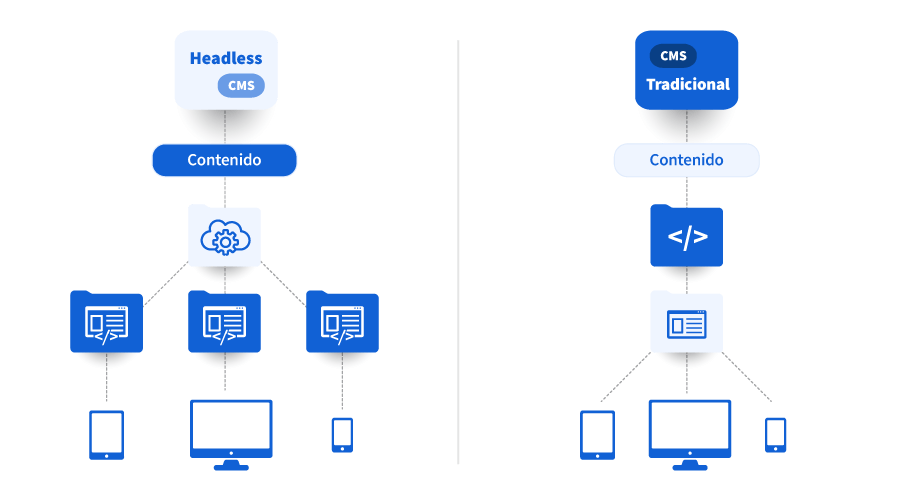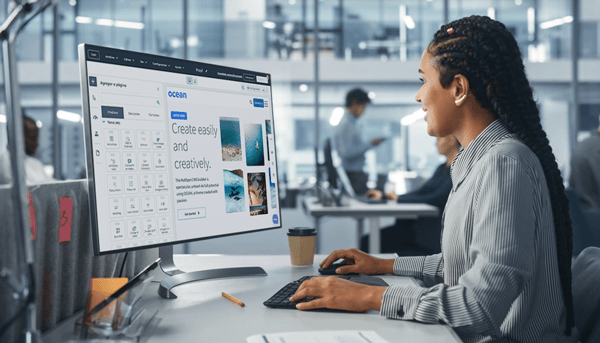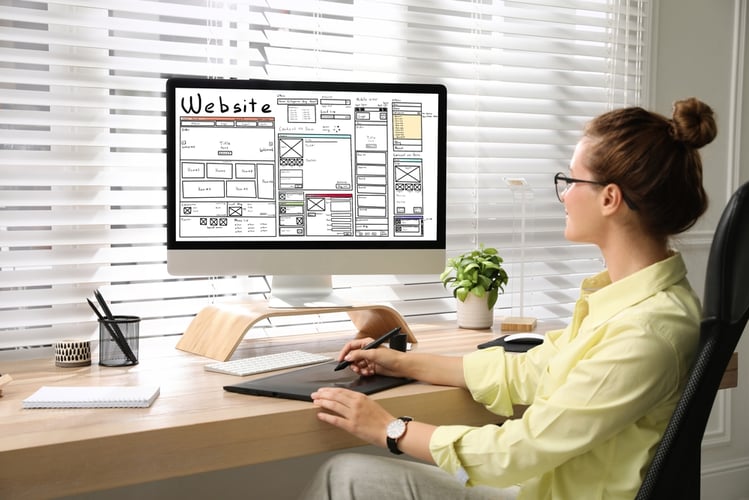Within content management systems, headless CMS stands out, separating the back-end system (body) from the client-oriented front-end (head).
This way, companies can deploy content across different channels, develop more quickly, and customize the interface more easily, thereby enhancing the user experience.
If you want to know why you should opt for a headless CMS for your website, here's the most important information! Ultimately, you'll be able to make the best decision for your business.
How Headless CMS Works

Headless CMS are editors and repositories that allow you to create and manage content through the back-end interface and deliver it to any front-end or user interface.
Most companies typically provide content such as blogs, articles, videos, and images to their customers through apps, social media, and websites, usually using these CMS to separate content management and storage, as it is a more efficient and cost-effective solution.
It also allows you to reuse and mix content across different multimedia and digital channels without incurring duplication costs.
Headless CMS vs. Traditional CMS

The main difference between these two is that a traditional CMS is designed for single-use and single-site purposes, as they are hosted on-site and their scope is limited.
On the other hand, a headless CMS is designed to implement content across different sites and attract attention on multiple devices.
They can create dozens of pages and give them solid use, being especially functional for companies looking to grow and progress rapidly.
A headless CMS provides a better solution for delivering content across different devices, channels, and formats, enabling businesses or entrepreneurs to effectively respond to changing market demands and adapt to new technologies.
Key Features of Traditional CMS
- On-premise hosting and delivery
- Monolithic back-end system
- Limited device support
- Scheduled updates
Key Features of Headless CMS
- Cloud hosting and delivery
- Microservice-based back-end system
- Unlimited device support
- Continuous updates
Benefits of Using a Headless CMS for Your Site

Large organizations often opt for headless CMS for content management, but increasingly, small businesses are also finding significant benefits from employing this approach.
This type of CMS is ideal for any business looking to build an interactive and dynamic website and desires the freedom to easily update its content without depending on a web developer.
Additionally, it provides the freedom to access your content from any device, offering great versatility, which is highly valued nowadays.
In addition to this, it provides other benefits, which I'll explain below.
1. Freedom to use any supported front-end system
By choosing a headless CMS, you avoid being tied to a specific platform, as the content is accessible through an API, making it easy to use with different types of devices.
Being served from an API means you can choose your front-end system and switch frameworks without affecting the CMS backend.
This way, if your development team has a particular technology or programming language they feel most comfortable working with, the headless CMS system allows them to maintain what works within their preference while optimizing their processes and developing efficiency.
2. Easily make changes to your site or application
They provide you with the great possibility of making changes within your website or applications very easily. All of this, without paying attention to the code.
The content infrastructure eliminates the need for copy and paste, as it unifies it in one place, and you can change text or images from the same location.
By offering centralized content management, all modifications are automatically applied across all places where the information appears, saving time, money, and keeping you ahead.
Additionally, headless CMS systems are very useful when it comes to collaboration because they replace the traditional waterfall development process with an agile framework.
3. Simple and fast scalability

A headless CMS is often more scalable than a traditional one because different servers and devices can be used. Therefore, it is the most suitable option for organizations that want dynamic and responsive websites.
Your website structure can continue to grow and change, according to the needs that arise, without any problems when modifying it, which is a tremendously important advantage for businesses that know they need to stay current.
4. Improved site performance
By opting for a headless content management system, your site may experience performance improvements, as separating the back-end from the front-end allows the server to focus solely on data delivery, while the front-end handles rendering and data presentation.
This separation reduces the server load and makes page load times faster, improving the user experience, especially on mobile devices and slower network connections.
5. Ease of managing multiple channels
One of the great benefits, as we have already seen, is that a headless CMS has the ability to distribute content coherently and efficiently across multiple channels.
This is especially useful in a digital environment where users interact with your brand through a variety of platforms and devices.
By choosing this type of CMS, you can create and manage content once and then distribute it through websites, mobile applications, digital screens, social media, and more automatically, reaching a wider audience and providing a consistent user experience across different touchpoints, strengthening your brand identity.
6. Enhanced security
Website security is a major concern in any project or company, and headless CMS offer advantages in this area.
By separating the front-end from the back-end, they reduce the potential attack surface for hackers, as the back-end server, responsible for storing and managing content, is not directly exposed to the network and is therefore less vulnerable to attacks.
Additionally, some of these CMS provide advanced security features, such as data encryption, two-factor authentication, monitoring of suspicious activity, etc., to ensure the protection of your website.
Best Headless CMS for Your Website

Building a website may seem challenging, but the reality is that it can be greatly simplified if you choose the right headless CMS for it.
Let me introduce you to some of the best options to help you make the final decision and generate good results.
HubSpot
HubSpot's CMS is ideal for both experienced professionals and beginners who need to create and manage their content.
The website creation tool features the incredible drag-and-drop functionality, allowing you to easily create pages by simply dragging and dropping modules or elements.
Additionally, it offers key tools for any business, such as A/B testing, personalization, data analysis, etc., and seamlessly integrates with other HubSpot platforms or some external ones.
Among the possibilities it offers is the use of website themes, such as Ocean Theme, which provides a module with all the necessary elements for a complete and powerful website, including video, text, and image resources, optimized loading, some SEO optimizations, and 100% customization.
If you want to implement this option successfully, one of the best ways is through HubSpot partners, such as Media Source.
Contentful
Contentful is a cloud-based CMS designed for SaaS companies.
One of its main features is that it combines the flexibility needed by developers with the content management and interface desired by marketing specialists.
It is a bit more complex to manage compared to HubSpot, but it is not overly complicated and offers integrations with other tools.
Strapi
Finally, Strapi is an open-source headless CMS, which is a good option for organizations that want to keep their content within their own systems.
Being open-source, developers have the freedom to customize various aspects of the program, but the process is much more complex to make it work effectively, requiring a specialized team.
How to Choose a Headless CMS

Now that you know why you should use a headless CMS to build your website and the best options to do so, it's important to understand how to choose the right one for your project.
There are some factors you should consider and questions you need to answer to make the correct decision.
- What type of content do you need to manage?
- How will you use that content?
- Who will be responsible for creating and managing the content?
- What is your budget for a headless CMS system?
- What technical experience do you have?
When you need to manage different types of content, require multiple teams to have access to it and handle it, and have little technical experience, the headless CMS is the best option.
Many of these CMS options are available as a SaaS (software as a service) solution, but there are others that allow you to manage hosting, databases, etc.
It's time to build your website
Now that you know why a headless CMS is a good option for your website, it's time to take action and decide on the best alternative to have a good digital asset and generate business through it.
If you need help achieving this or are not sure exactly which is the best path to take, we can help!
Get in touch with us so we can guide you in this task and you can have a website that is not only attractive but functional, converting people into potential customers for your company.

.png?width=319&height=267&name=gtmetrix_2023%20(1).png)




